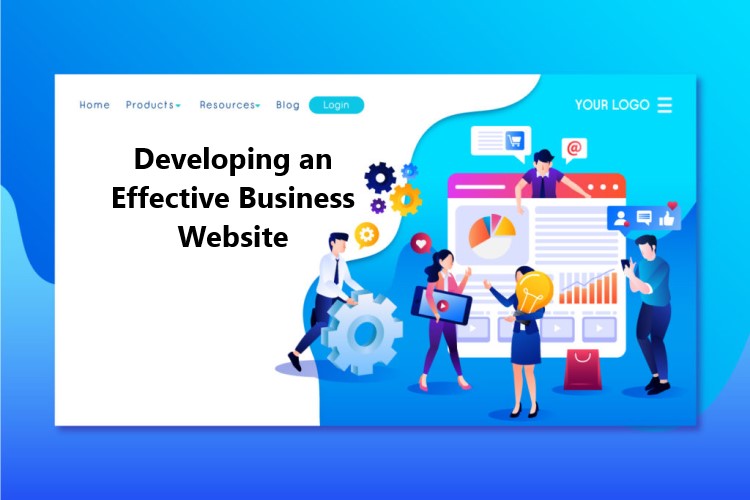
User Experience (UX) Design
When developing an effective business website, the importance of User Experience (UX) design cannot be overstated. A user-friendly interface ensures that visitors can navigate your site intuitively and efficiently, which is crucial for converting visits into engagements and transactions. Good UX design focuses on streamlining the path from entry to action, making sure that users find what they need without frustration.
For example, a well-organized layout with clear, logical navigation helps prevent users from feeling overwhelmed or lost. This is critical because if users can’t find what they’re looking for quickly, they’re likely to leave and not return. Additionally, page loading speed is a vital part of UX design. A fast-loading site keeps the user’s attention and reduces bounce rates.
Furthermore, consider the overall aesthetic of your website. It should reflect your brand’s image and values while being pleasing to the eye. Consistent use of colors, fonts, and style elements can create a cohesive look that enhances brand recognition.
Lastly, accessibility should be a key component of your UX strategy. Ensure that your website is accessible to people with disabilities, which not only broadens your audience but also complies with legal standards in many areas. Tools that allow for text to be resized, improved contrast, and keyboard navigation are examples of accessibility features that improve overall user experience.
By prioritizing these aspects of UX design, you not only enhance user satisfaction but also bolster the effectiveness of your business website as a tool for growth. Remember, a positive user experience translates directly to better engagement and increased loyalty, driving the success of your online presence.
Search Engine Optimization (SEO)
Search Engine Optimization (SEO) is a critical component when developing an effective business website. It enhances your website’s visibility on search engines like Google, making it easier for potential customers to find you. The key to SEO lies in optimizing both the content and structure of your website.
Firstly, focus on keyword optimization. Identify keywords that are relevant to your business and that potential customers might use to find services or products like yours. Once identified, strategically incorporate these keywords into your website’s content, such as the headlines, main page copy, and product descriptions. However, be mindful of overuse; stuffing your content with too many keywords can negatively impact readability and may be penalized by search engines.
Secondly, optimizing the structure of your website also plays a crucial role in SEO. This includes having a clear, logical sitemap that search engines can crawl easily. Ensure that each page and section of your website is accessible with as few clicks as possible from the home page. Additionally, URL structures should be simple and include relevant keywords to improve search relevance.
Another important aspect is to ensure your website is mobile-friendly. With increasing numbers of users accessing the internet via smartphones, search engines favor websites that perform well on mobile devices. This includes faster loading times and responsive design that adapts to different screen sizes.
Lastly, never underestimate the power of quality content. Regularly updated articles, blogs, or videos not only engage readers but also encourage them to spend more time on your site, which can boost your search engine rankings.
By focusing on these SEO strategies, you enhance your website’s visibility and attractiveness to both search engines and users. This is essential for any business looking to grow its online presence effectively.
Mobile Optimization
Mobile optimization is a crucial aspect of developing an effective business website. As more users access the internet via smartphones and tablets, ensuring your website performs well on these devices is essential. A mobile-responsive design adjusts the layout of your website to fit the screen size and resolution of the device being used, providing an optimal viewing experience.
First, consider the navigation of your website. On mobile devices, space is at a premium, so it’s important to have a simplified, easy-to-use navigation menu. This might mean a collapsible menu or a simplified top navigation bar that makes it easy for users to explore your site with just a few taps.
Second, pay attention to the load times of your pages. Mobile users often have less patience for slow-loading websites, especially when using mobile data. Optimizing images, minimizing code, and using mobile-specific features like accelerated mobile pages (AMP) can help reduce loading times and keep your visitors engaged.
Additionally, touchscreen friendliness is an important aspect of mobile optimization. Buttons and links should be easy to tap with a finger without zooming in, and forms should be simple to fill out on a small screen. The more intuitive your site is, the better the user experience.
By prioritizing mobile optimization, you not only enhance user experience but also improve your website’s search engine ranking. Google and other search engines prioritize mobile-friendly websites in their search results, which can lead to increased traffic and better conversion rates. Remember, a mobile-responsive website is no longer just an option; it’s a necessity for attracting and retaining modern internet users.
Content Strategy
Developing an effective business website involves crafting a content strategy that not only engages visitors but also supports your business objectives. The key to this is creating compelling and valuable content that resonates with your audience and encourages them to take action.
Start by understanding your audience. Knowing who you are writing for is essential to creating content that they will find useful and relevant. Conduct audience research to determine their preferences, pain points, and the types of content they consume. This information will guide the topics you choose and the tone you use.
Next, focus on the quality of the content. High-quality content is informative, well-researched, and well-written. It should provide real value to your visitors, whether by solving a problem, offering insights, or entertaining them. Remember, content that serves a clear purpose is more likely to engage readers and keep them coming back.
Additionally, your content should be optimized for search engines to help improve your website’s visibility online. Use relevant keywords naturally within your text, include meta descriptions, and create content that encourages other sites to link back to yours. However, make sure your primary focus remains on the quality and relevance of your content to your audience.
Lastly, maintain a consistent publishing schedule. Regular updates keep your website dynamic and signal to both visitors and search engines that your site is active and relevant. Plan your content in advance and align it with key business events, seasons, or product launches to maximize its impact.
By integrating these practices into your content strategy, you can create a website that attracts visitors, engages them meaningfully, and contributes to achieving your business goals.
Security Features
When developing an effective business website, incorporating robust security features is essential to protect both the site and its users. Key components like SSL certificates and secure payment gateways are fundamental to safeguarding personal and financial information.
An SSL (Secure Sockets Layer) certificate is crucial for any business website. It encrypts the data exchanged between a user’s browser and your website, ensuring that sensitive information such as login credentials and credit card numbers are protected from interception. This not only secures user data but also boosts consumer confidence in your website. Moreover, search engines favor HTTPS-enabled sites, which can enhance your site’s SEO performance.
Secure payment gateways are another vital feature, especially if your website involves financial transactions. Integrating trusted payment gateways ensures that all payment processes are encrypted and secure. This not only helps in protecting against fraud but also reassures your customers that their financial transactions are safe, which is vital for maintaining trust and credibility.
Additionally, regularly updating your website’s software and plugins is critical. This prevents attackers from exploiting known vulnerabilities, which are often patched in newer updates. Implementing strong, regularly updated security measures can protect your website from various threats, including data breaches and malware attacks.
By prioritizing these security practices, you not only protect your website and its users but also reinforce the reliability and integrity of your business. In today’s digital age, a secure website is not just an asset; it’s a necessity.
Analytics and Feedback
Utilizing web analytics is crucial when developing an effective business website. It helps you understand visitor behavior and optimize the user experience with real data. Tools like Google Analytics provide insights into user interactions, tracking metrics from page views and bounce rates to conversion paths and content effectiveness.
These metrics enable you to make informed decisions about website design and content strategy. For example, high exit rates on certain pages might indicate unengaging content or confusing layouts. Analyzing traffic sources also helps refine your marketing efforts, focusing on channels that drive quality traffic.
Besides web analytics, implementing feedback mechanisms is vital. This can include customer surveys, feedback forms, and comment sections on your website. Direct feedback offers actionable insights that analytics alone might not reveal. Visitors could highlight usability issues or suggest additional content on specific topics.
Regularly collecting and analyzing both quantitative data from analytics and qualitative feedback from users promotes continuous improvement. This strategy enhances your website’s design and functionality while aligning with user needs and preferences. By seeking and responding to user input, you show a commitment to customer satisfaction, boosting loyalty and engagement.
Conclusion
In conclusion, developing an effective business website requires a holistic approach that integrates several key elements. Ensuring a responsive user experience keeps your site accessible on all devices. Implementing robust SEO strategies enhances your visibility on search engines. Each component is crucial.
Prioritizing security protects your data and users, building trust in your brand. Focusing on content strategy and mobile optimization greatly enhances user engagement and satisfaction. This directly boosts your site’s effectiveness and conversion rates. Integrating analytics and feedback mechanisms allows continuous refinement of your website. This ensures it evolves with your business needs and user expectations.
By considering these aspects, you prepare your website and your business for success. A well-crafted website is an investment in your company’s future. It serves as a crucial tool in your marketing and service delivery efforts. As you implement these strategies, you meet current digital demands and anticipate future trends and user needs.


